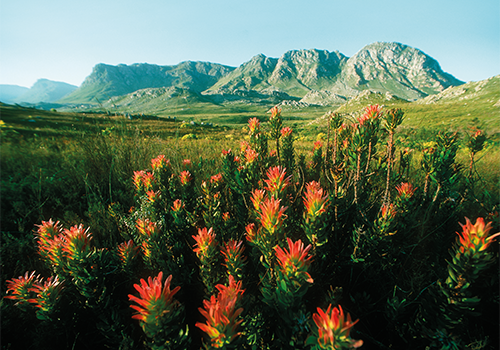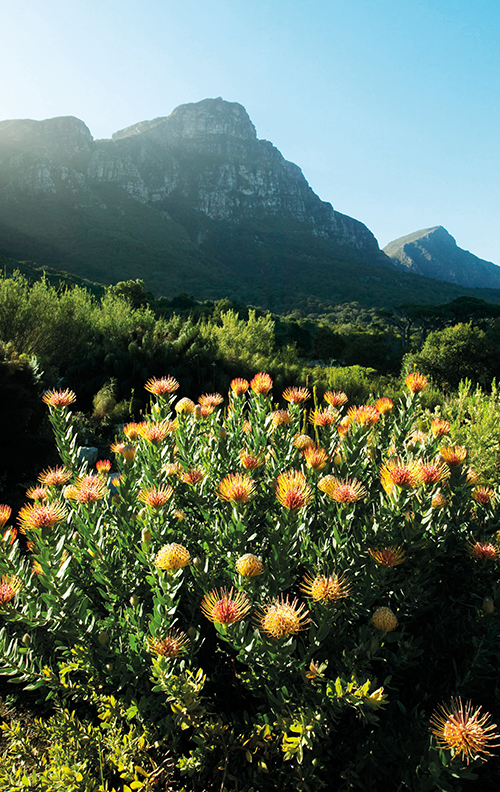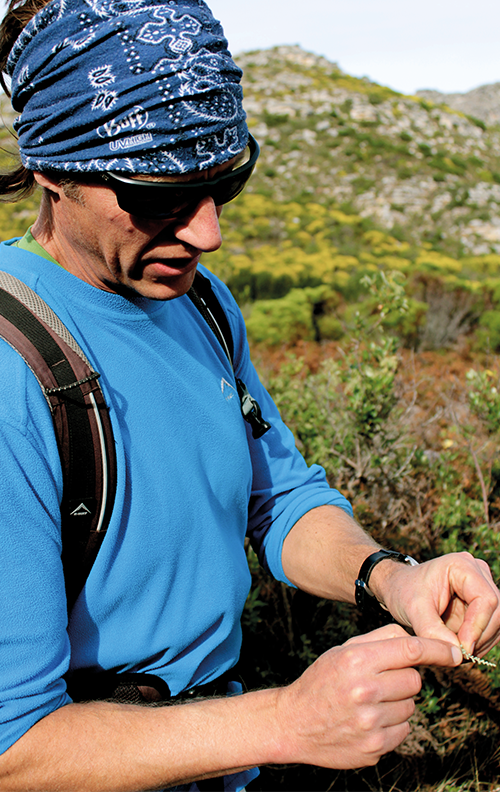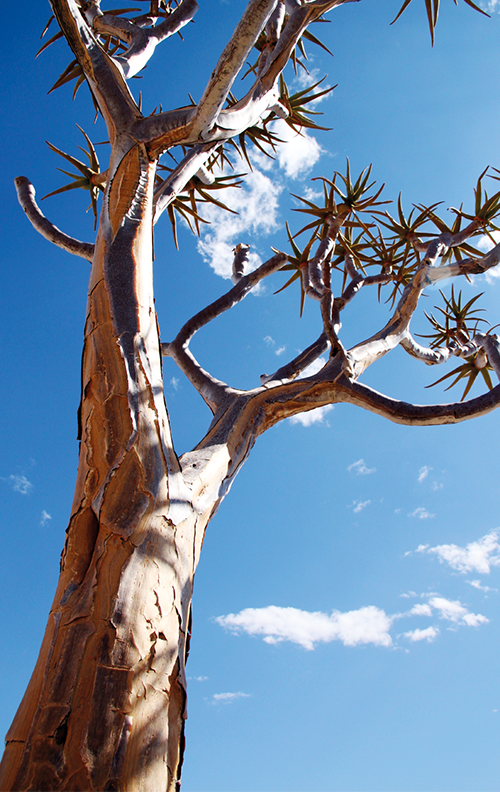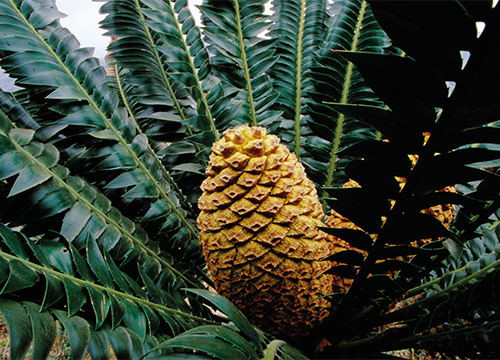Each spring, wild-flower enthusiasts are drawn to Namaqualand to witness a landscape carpeted in infinite botanical hues. Keith Bain climbs a mountain in search of floral wonders even closer to home
Stand aside, Bear Grylls. Where we are headed, there’s nary a nut to nibble, never mind a rat to roast. Besides a few bulbs to forage, and maybe something mildly euphoria-inducing to boil into a tea, the windswept mountains of the Cape Peninsula offer little in the way of nutrition. This explains why the strandlopers who lived here before the Europeans arrived harvested most of what they needed from the seashore, feasting on washed-up whales and trapping fish in the rocks.
It’s also why Dominic Chadbon has packed chocolate croissants and a flask of coffee to tide us over as we explore the fynbos-smothered Silvermine section of Table Mountain National Park. It is soon after sunrise and the current hiking guide, schooled historian, former rugby player, reformed dinosaur enthusiast and self-confessed fynbos geek is firing off astonishing statistics.
Did you know that, along with Brazil and Indonesia, South Africa is one of the world’s most biodiverse countries? Or that the smidgen of land covered by the south-western Cape is home to an entire plant kingdom, the Cape Floral Kingdom? Other floral kingdoms – and there are only six in total – occupy vast regions. One covers the continent of Australia, another sprawls across most of the northern hemisphere.
So, it’s a pretty special place. Even if, as we sit on a rock sipping coffee after scrambling up a craggy section, it’s tricky to put my finger on what could possibly make these scraggly green, yellow and grey bushes so special. Darwin himself, when he travelled across the peninsula, described it as ‘very desert’. He should have had Dominic on his team.
‘People find fynbos overwhelming,’ he says. ‘It looks so insignificant, stunted and boring. But it’s a paradox. From a distance, it doesn’t look like much at all. But when you’re in it, you’re over-whelmed, because there’s so much.’
The first thing for aspiring plant sleuths to understand is that ‘fynbos’ doesn’t refer to a single plant or family of plants. It refers to a vegetation type.
‘It’s on the same level as saying, “We’re standing in a jungle, or we’re standing in the savannah”,’ Dominic says.
‘And people also underestimate fynbos, because it isn’t sexy,’ he says. ‘It’s not in the same league as, say, tropical rainforest, where everything seems exotic.’
Yet, from a botanical perspective, it is wildly exciting. Nowhere on Earth is more diversity packed into a smaller space. ‘Rainforests may have more plants within a certain area, but those species reoccur over vast areas. By contrast, there is an incredible difference between the fynbos right here, and,’ he points a short distance off, ‘over there.’
The Cape Peninsula – measuring just 470 km² – is home to roughly the same number of species as the British Isles or New Zealand. Besides the extraordinary number of species, there are also amazing examples of endemism. Fynbos species demonstrate remarkable adaptations to very specific conditions.
‘There are plants here at Silvermine that only occur in these mountains. Don’t go looking for them on Table Mountain or at Cape Point. They’re only here, and over there, slightly to the right,’ says Dominic.
‘Some fynbos plants grow exclusively along a 200m stretch of a very specific rocky outcrop facing the Atlantic at Cape Point.’
Another example is the tiny nature reserve in the middle of Kenilworth Racecourse, which shelters the highest diversity of plant life, relative to its size, of any urban remnant of natural vegeta-tion in the world, he says. That includes several ericas found nowhere else and even an endemic species of frog.
The specificity Dominic describes reminds me of the Galápagos Islands, where Darwin discovered that isolation had resulted in environment-peculiar adaptations by the indigenous animals. In fact, he explains, many million years back, the Cape Peninsula was an island. Remoteness helps to explain why, of the nearly 2 300 plant species found in the 470 km² Cape Peninsula, around 150 are endemic.
The downside of being a biodiversity hotspot, is that it is also an extinction hotspot. Pointing toward the Cape Flats, Dominic says the area has the world’s highest concentration of International Union for Conservation of Nature Red List plant species – a scary 15 per km² are in danger of extinction.
Most people recognise the proteas, ericas and reed-like restios that are the signature fynbos plants, but many other families are virtually unknown because they’re so unique, endemic and highly specialised – the kinds of plants that botanists travel here to see.
On the other hand, ‘fynbos is also full of very well-known plant families. Often, they are so familiar that you struggle to imagine how they fit in.’
Daisies are a prime example. There are a thousand species of daisies within fynbos – without seeing the distinctive flowers, you’d never guess at some of them. Dominic shows me one example, blombos (Metalasia muricata), which can be used to make tea. Then he has me rubbing the leaves of another plant. They’re sticky, with a very unusual scent. It’s slangbos (Seriphium plumosum).
‘Also a daisy,’ he says.
The uses for fynbos are as varied as the plants themselves. Some of them were traditionally used to make ink, while others provided raw material for rope or stuffing for mattresses; and the common sugarbush (Protea repens) was used as – you guessed it – a sweetener. They were also used for their medicinal properties to treat a range of ailments, from epilepsy and warts, to difficult childbirths and erectile dysfunction.
Others had slightly more arcane uses. The roots of one plant were crushed up and thrown into slow-moving streams or ponds, poisoning fish, which would then float to the surface belly-up, but could be eaten because the toxin isn’t harmful to humans.
‘And what possesses anyone to figure out that the spotted aloe’s roots can be used as a dye?’ asks Dominic.
Equally baffling are the ingenious ways in which plants have adapted to ensure pollination. As we hike, Dominic constantly has me sniffing. One bush with incredibly beautiful flowers smells like nothing.
‘Come back at dusk,’ he says, ‘and it will smell overpoweringly like Sta-Soft.’
Why? Because it is moth-pollinated, so – like someone dousing themselves with perfume before hitting the town – it doesn’t bother with its scent until after dark.
Similarly, ‘some ground orchids smell like baking bread. They put out a yeasty scent to attract mice and elephant shrews, which pollinate them.’
Even the abundant red blooms of spring and summer are part of highly specialised pollination strategies. The red disa (Disa uniflora Bergius) – an elegant orchid that’s the familiar symbol of the Western Cape – is pollinated exclusively by the Table Mountain beauty butterfly (Aeropetes tulbaghia).
‘That butterfly,’ says Dominic, ‘is mad for red, so the disa produces a big, bright red orchid in February, the hottest month of the year. Because that’s the only time the butterfly is around.’
Aesthetics aside, says Dominic, it’s the relationship these plants have with fire that’s truly incredible. Many fynbos seeds can remain underground for 30, 40 or more years waiting for specific conditions to trigger germination. Some even bear fruit that won’t open without a fire.
Restio seeds can be dropped at any time of year, but they are coated in a substance that’s especially tasty to ants. So the insects collect the seeds and feed on their nutritious coating while they stay safely stored below ground. They are ready to germinate, but only when triggered by chemicals in the smoke of a fire.
You needn’t wait for a big burn to witness the miracle of the Cape’s flora, though, says Dominic.
‘One of the great secrets of fynbos is that beneath the ground are billions of bulbs waiting for the winter rains so they can emerge and flower in spring. Every year, this seemingly barren earth reveals a treasure trove: irises, orchids, hyacinths, gladioli, watsonias, freesias … all kinds of small miracles.
‘Look carefully, though, because there’s always the chance of spotting something so rare you may be the first to witness it in a very long time. Or, quite possibly, the last.’
A walk with The fynbos-whisperer
Dominic Chadbon (The Fynbos Guy) specialises in leading fynbos-spotting hikes (ranging from half- to multi-day), in and around Cape Town (mostly Table Mountain, Cape Point and Silvermine). He also covers the Overberg’s Green Mountain Trail (a slackpacking route with incredible fynbos), Jonkershoek, Hottentots Holland and, occasionally, the Cederberg.
Dominic’s knowledge of the different areas within the Cape Floral Kingdom is staggering, but he’s also entertaining and his grasp of the big picture deepens the experience considerably. Besides flora and fauna, he’ll inform you about ecology, climate, geology and human history, and share his strong opinions on human impact – both good and bad. Spend a day with him and you will be fynbos-whispering in no time at all.
More weird and wonderful plants
The living fossil
Inconspicuous, wilted, dead-looking, ugly… Sling whatever insults you like at the slow-growing Welwitschia mirabilis; it remains a marvel of nature. Known in Afrikaans by the more descriptive name tweeblaarkanniedood (literally ‘two leaves cannot die’), it comprises two leaves that grow directly out of the earth.
Looking a little like something that’s been splattered on the ground and left to wither in the sun, its leaves keep on growing, coiling round and drying out, attaining considerable length. In the meanwhile, its roots extend up to 3m beneath the surface. It’s thought that it changes the chemical composition of the soil around it, so as to create an inhospitable environment for younger plants and improve its own chances of survival.
Endemic to the Namib Desert, this botanic oddity can be best seen in the Welwitschia Plains east of Swakopmund, where the plants are among the oldest in existence – some of the largest ones believed to be 2 000 years old.
A permit is required to enter this area of the Namib-Naukluft Park. It can be obtained from the Ministry of Environment & Tourism office in Swakopmund, corner of Bismarck Street and Sam Nujoma Avenue.
The upside-down tree
According to San legend, the baobab tree looks the way it does because it offended God and was consequently planted upside down. They believe that spirits dwell in its flowers, which only bloom at night, and anyone who picks them will be mauled by a lion.
Only two of the world’s nine baobab species (the common Adansonia digitata and the newly described kilima) occur on the African mainland. Among these is the Sunland Baobab in Modjadjiskloof, Limpopo, considered the largest living specimen in the world, big enough to house a bar within its hollow interior.
One baobab species is endemic to Australia and the other six are found
in Madagascar, where people believe ancestral spirits live in specific trees and leave offerings of honey and rum for them in giant land snails’ shells. Despite the Malagasies’ reverence for the baobabs, three of the species are endangered, including Grandidier’s baobab (Adansonia grandidieri), the tallest species, which can grow up to 30m tall. Known locally as renala (‘mother of the forest’), the Grandidier’s baobab is star of the much-photographed Avenue of the Baobabs, near Morondava in western Madagascar, where a dozen or so of the trees line a narrow sandy road, the emptiness surrounding them testament to the relentless destruction of the indigenous forest.
For information on the Sunland Baobab, visit www.bigbaobab.co.za. To find out more about Madagascar’s unique natural heritage, check out www.madagascar-tourisme.com/en.
The desert wonder
The quiver tree, also known as the kokerboom, (Aloe dichotoma Masson) isn’t a tree at all, but in fact a tall aloe that can reach heights of 7m. The plant takes its name from the fact that its bark has traditionally been used by the San to make quivers for their arrows.
It’s found throughout the Northern Cape and Namibia, where you’ll usually see only solitary specimens. But, about 13 km north-east of Keetmanshoop, on the farm Gariganus, is the Quivertree Forest. This site has been proclaimed a national monument because it is so rare and unexpected – one of only a handful of such forests, the plants 300 years old. The spot is especially appealing at sunset, when the trees glow a golden-red.
Another natural wonder worth a visit to Gariganus is the Giant’s Playground, where colossal dolerite rocks balance precariously on one another, forming extraordinary sculptures.
For more information about these sites, visit www.quivertreeforest.com.
The Rain Queen’s forest
The Modjadji cycad (Encephalartos transvenosus) is named after the rain-making queens who’ve lived in Modjadjiskloof since the 16th century and whose duties include guarding the forest. The 305 ha Modjadji Nature Reserve, which is thought to exist much as it did in prehistoric times, contains the world’s biggest single-species concentration of cycads. It is the only place on Earth where this type of forest occurs, with the ancient cycads measuring up to 13m and some producing cones weighing more than 30 kg.
Modadjiskloof (also known as Duiwelskloof) is 21 km north of Tzaneen along the R36. For more information, visit www.golimpopo.com.
Photography Keith Bain, Marianne Majerus, Gallo/Gettyimages, istockphoto
(This article was first published in the spring 2014 issue of AA traveller magazine)

